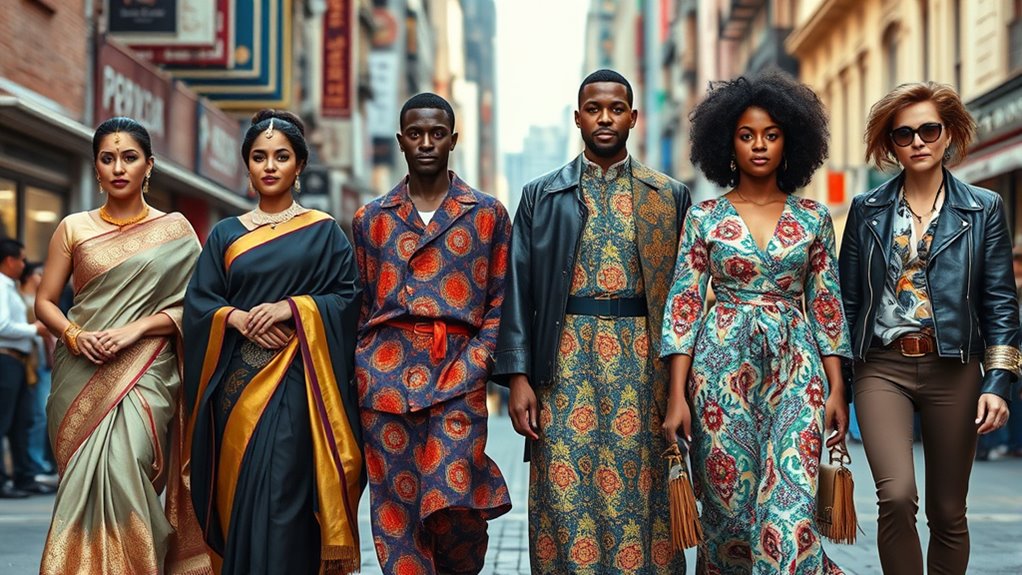Cultural influences shape your style by blending traditional textiles, symbols, and motifs from around the world into modern fashion. African fabrics bring bold colors and intricate patterns, Asian garments inspire fusion styles like kimono jackets, and European heritage influences timeless silhouettes. Indigenous techniques emphasize sustainability, while festivals highlight regional craftsmanship. These diverse elements celebrate heritage, creativity, and cultural pride. If you keep exploring, you’ll discover how these traditions continue to inspire global fashion trends today.
Key Takeaways
- Traditional textiles like African Ankara and Asian kimono fabrics introduce vibrant colors and intricate patterns into modern fashion.
- Cultural symbols and motifs in clothing convey identity, social status, and historical narratives globally.
- Festivals and cultural events inspire fashion trends through traditional attire, accessories, and craftsmanship.
- Fusion styles blend heritage garments with contemporary streetwear, promoting cultural pride and innovation.
- Sustainable fashion draws on indigenous techniques, natural dyes, and locally sourced materials rooted in cultural traditions.
The Impact of African Textiles and Patterns
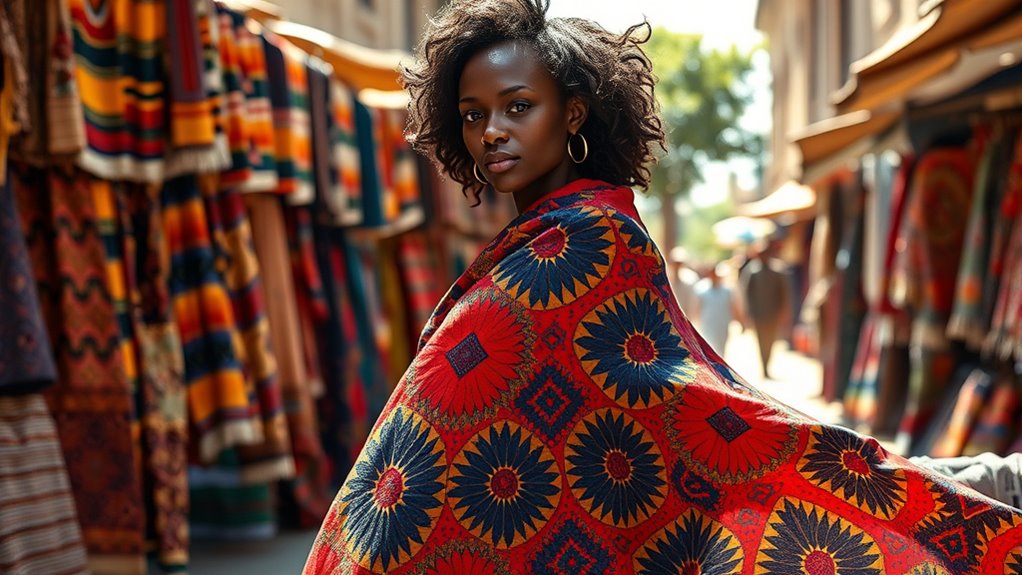
African textiles and patterns have profoundly shaped global fashion by bringing bold colors and intricate designs to the forefront. When you see vibrant Ankara fabrics or the geometric motifs of Kente cloth, you’re witnessing a tradition that celebrates storytelling and cultural identity. These textiles often feature symbolic patterns that convey messages, histories, and social status. Designers worldwide incorporate African-inspired prints into modern clothing, making traditional elements more accessible and fashionable. You might notice these patterns in high fashion runways or everyday streetwear, reflecting a blend of cultural expression and contemporary style. By embracing African textiles, you participate in a global movement that values diversity and heritage, transforming traditional crafts into symbols of innovation and cultural pride.
Asian Traditional Garments and Modern Fusion

You’ll notice how traditional Asian garments, like kimonos and sarees, influence modern fashion with their distinctive elements. Designers often blend these features with contemporary styles to create fresh fusion trends. This combination keeps cultural heritage alive while making fashion more innovative and accessible.
Traditional Elements in Modern Wear
Asian traditional garments, such as the kimono, cheongsam, and hanbok, have profoundly influenced modern fashion by inspiring fusion designs that blend historical elements with contemporary styles. You’ll notice how designers incorporate traditional silhouettes, fabrics, and motifs into everyday wear, creating a bridge between past and present. This fusion allows you to express cultural pride while staying stylish and relevant. It also encourages appreciation of diverse heritages and fosters a deeper connection to history through fashion. Incorporating vintage decor and craftsmanship into contemporary looks further enriches this cultural dialogue.
Fusion Fashion Trends
Fusion fashion trends seamlessly blend traditional Asian garments with modern design, creating innovative styles that appeal to contemporary tastes. You might see a qipao-inspired dress with edgy cuts or a kimono jacket paired with streetwear. This mix allows you to honor cultural heritage while expressing individuality. Designers experiment with fabrics, patterns, and silhouettes, making traditional elements more versatile for everyday wear. For example, a cheongsam-inspired top combined with jeans offers a fresh, stylish look. These trends reflect a globalized world where cultural exchange fosters creativity. By embracing fusion fashion, you can celebrate Asian traditions in a way that feels current and personal. It’s about respecting heritage while pushing boundaries, making fashion a true reflection of cultural interconnectedness.
European Heritage and Contemporary Fashion Trends
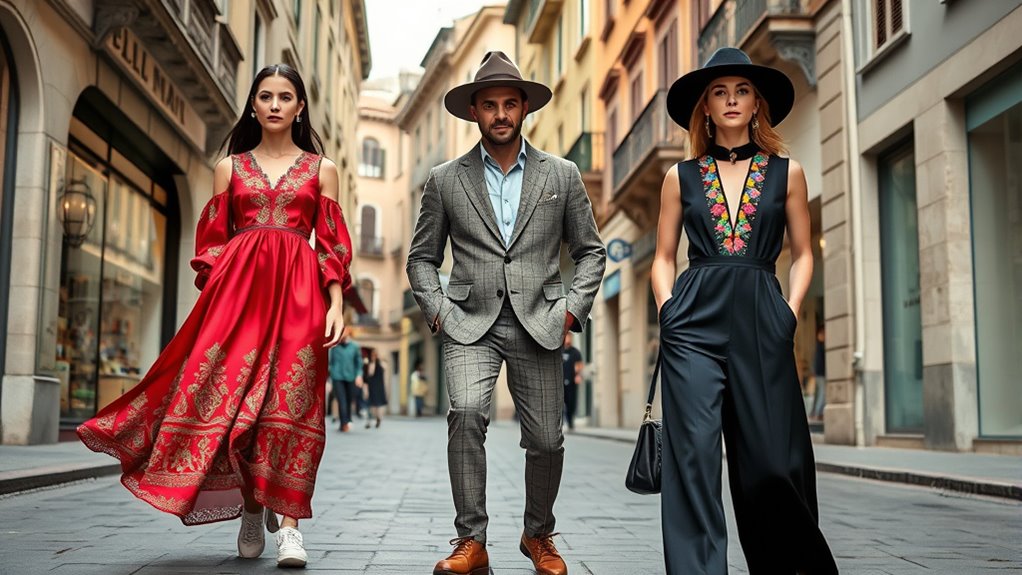
How does European heritage continue to shape contemporary fashion trends? You see it in the revival of classic silhouettes, luxurious fabrics, and intricate craftsmanship. Designers draw inspiration from historic art, architecture, and traditional textiles, blending old-world elegance with modern innovation. European heritage encourages a sense of sophistication and timeless style that remains relevant today. It also fosters a cultural pride that persists through generations. Additionally, educational toys play a role in fostering creativity and appreciation for craftsmanship among young designers, ensuring that traditional techniques are passed down and celebrated. Incorporating AI tools into design processes further enhances innovation and streamlines the preservation of traditional techniques. Moreover, integrating leadership skills into design education helps emerging designers cultivate innovation and strategic thinking, ensuring the preservation and evolution of these rich traditions. Developing a problem-solving mindset is essential for adapting classic elements into contemporary fashion.
Indigenous Influences and Sustainable Style

Indigenous influences are increasingly shaping sustainable fashion by inspiring designs rooted in tradition, community, and ecological harmony. You’ll notice how many brands incorporate traditional techniques like handwoven textiles, natural dyes, and locally sourced materials, honoring indigenous craftsmanship. This not only highlights cultural diversity but also encourages consumers to value authentic craftsmanship and ethical production methods. Incorporating these elements often involves environmentally friendly practices that reduce ecological impact while celebrating indigenous stories. This approach is supported by the integration of AI security technologies that help ensure transparency and traceability in supply chains, promoting ethical sourcing. These practices support fair wages and empower communities to preserve their cultural heritage. By prioritizing eco-friendly practices, designers aim to reduce environmental impact while celebrating indigenous stories. You might see clothing that uses biodegradable fibers or repurposed indigenous textiles, emphasizing sustainability. Recognizing how cultural preservation is integral to these efforts fosters respect for indigenous knowledge and promotes responsible consumption. Additionally, the use of traditional techniques in modern fashion underscores the importance of safeguarding cultural identities in a rapidly globalizing world. As you explore fashion today, you’ll find that embracing indigenous styles isn’t just about aesthetics but also about honoring the planet, supporting marginalized communities, and ensuring cultural preservation for future generations.
Cultural Symbols and Their Fashion Significance
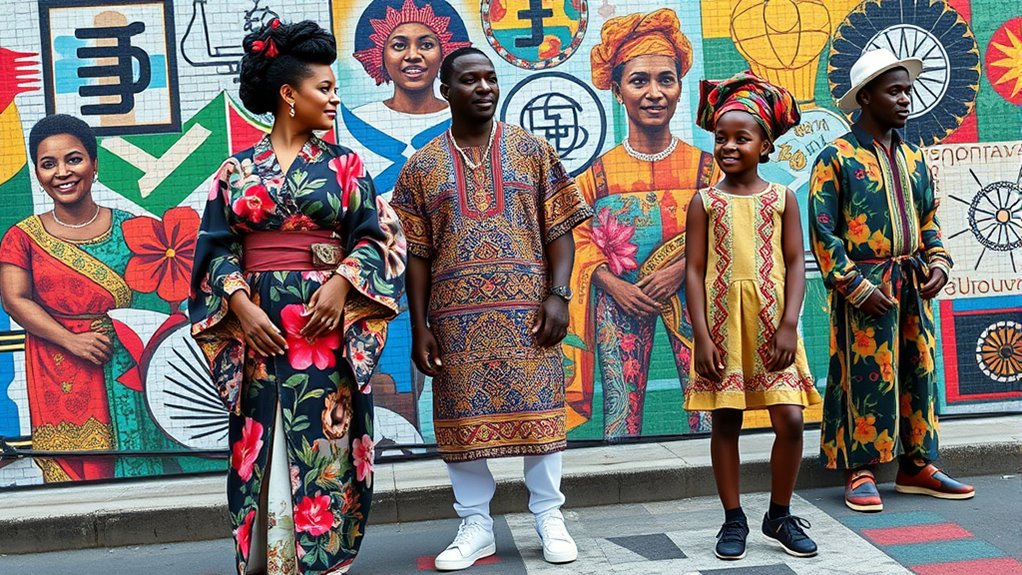
Cultural symbols play a powerful role in fashion by conveying identity, history, and values through clothing and accessories. When you wear a symbol, you’re expressing more than style—you’re sharing a story. These symbols can represent spiritual beliefs, social status, or cultural heritage. For example, certain colors, patterns, or motifs carry specific meanings that connect you to your roots or community. Recognizing these symbols helps you appreciate their significance beyond aesthetics. Understanding textile art techniques can deepen your appreciation for the craftsmanship behind these cultural symbols and their integration into fashion. Additionally, knowledge of cultural symbolism can provide insight into the historical context and societal importance of these motifs, and exploring traditional embroidery methods can reveal the intricate processes that bring these symbols to life. Exploring butter’s artistic influence offers a unique perspective on how traditional materials and motifs are incorporated into cultural expressions, enriching your understanding of their significance. Being aware of drivetrain components and their features allows for better maintenance and appreciation of the craftsmanship involved in creating traditional textiles and clothing.
The Role of Festivals and Celebrations in Shaping Trends
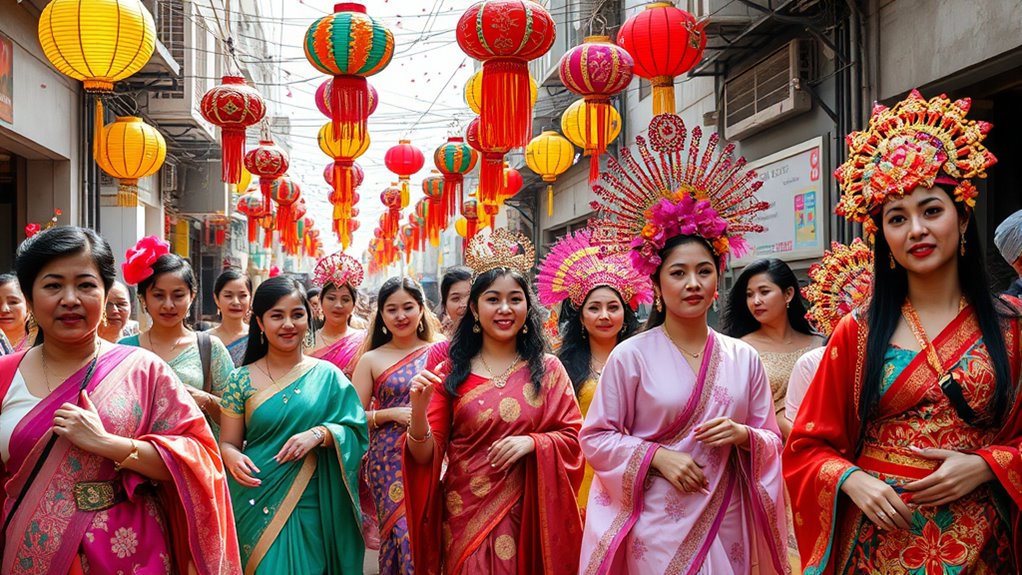
Festivals and celebrations serve as vibrant platforms that influence fashion trends by showcasing unique styles, colors, and accessories. When you attend a festival, you often adopt the traditional attire or incorporate elements inspired by the event’s cultural significance. Bright colors, intricate patterns, and distinctive accessories become prominent, inspiring everyday fashion choices. These events encourage experimentation, allowing you to blend modern trends with cultural symbols, creating fresh looks. For example, during Mardi Gras, bold masks and beads gain popularity, while Diwali’s vibrant saris influence contemporary ethnic wear. Festivals also promote sustainable fashion, as handmade and locally sourced items gain appreciation. Incorporating cultural symbolism into attire helps celebrate diversity and fosters a deeper connection to the traditions behind each event. Additionally, the use of traditional textiles during celebrations highlights regional craftsmanship and supports local artisans. Recognizing the importance of cultural heritage in fashion, designers often draw inspiration from these festivals to create innovative collections. Furthermore, understanding the role of regulations and compliance can help ensure that traditional costumes adhere to cultural sensitivities and legal standards. Building awareness of cultural influences can also inspire more respectful and meaningful fashion choices. Ultimately, these celebrations act as dynamic showcases that inspire you to embrace cultural diversity and incorporate it into your personal style.
Frequently Asked Questions
How Do Local Artisans Influence Global Fashion Markets Today?
You might notice local artisans shaping global fashion markets through their unique craftsmanship and traditional techniques. When designers incorporate their handmade textiles, intricate patterns, or sustainable practices, you see a blend of authenticity and innovation. This influence helps you embrace diverse styles, supports local economies, and promotes cultural preservation. By choosing these pieces, you’re actively participating in a worldwide movement that values craftsmanship and celebrates cultural diversity in fashion.
What Role Does Technology Play in Preserving Traditional Styles?
Technology plays a crucial role in preserving traditional styles by digitizing craftsmanship and cultural knowledge. You can access detailed tutorials, virtual museums, and online marketplaces that showcase artisans’ work, helping keep these traditions alive. It also enables you to connect with artisans worldwide, supporting ethical fashion. By documenting and sharing traditional techniques digitally, you help protect cultural heritage while promoting diversity in modern fashion.
How Do Political Changes Affect Cultural Fashion Expressions?
Political changes deeply impact your cultural fashion expressions by shaping societal norms and values. When governments shift, they can promote or suppress certain styles, influencing what you wear to reflect identity or resistance. Policies may encourage traditional attire or push for modern trends, affecting your clothing choices. As politics evolve, your fashion becomes a powerful statement of your cultural stance, allowing you to express solidarity, dissent, or heritage through what you wear.
Can Fashion Trends From Festivals Influence Everyday Wear?
Think of fashion trends from festivals as sparks that can ignite everyday style. You might find yourself incorporating bright colors, unique accessories, or relaxed vibes into your daily wardrobe. These trends act like a gust of fresh air, making your look more expressive and fun. So, yes, festival-inspired fashions can influence your daily wear, helping you stay trendy and true to your personal style.
How Do Cultural Taboos Impact Fashion Design Choices?
Cultural taboos profoundly impact your fashion choices by shaping what’s acceptable or offensive in different settings. When designing or choosing outfits, you need to take these taboos into account to respect traditions and avoid controversy. For example, covering shoulders or knees might be necessary in some cultures. By understanding and respecting these boundaries, you can create or select fashion that honors cultural sensitivities while expressing your style confidently.
Conclusion
As you explore global fashion, remember that over 70% of people worldwide wear traditional textiles daily, blending heritage with modern style. This vibrant mix reflects how cultural symbols and celebrations influence trends everywhere. By embracing these diverse influences, you become part of a colorful journey that bridges tradition and innovation. So, next time you choose an outfit, think of it as a wearable story—connecting you to a rich tapestry of cultures shaping the world’s fashion scene.
